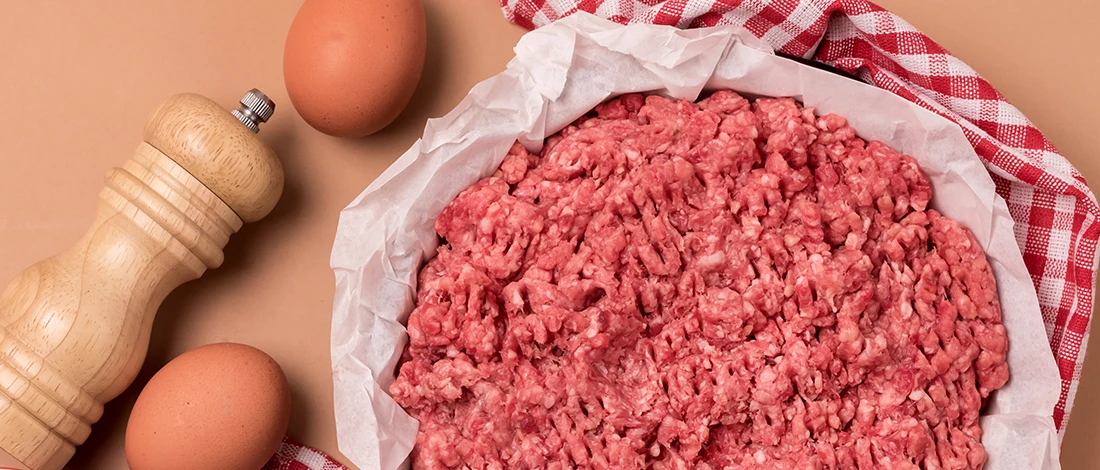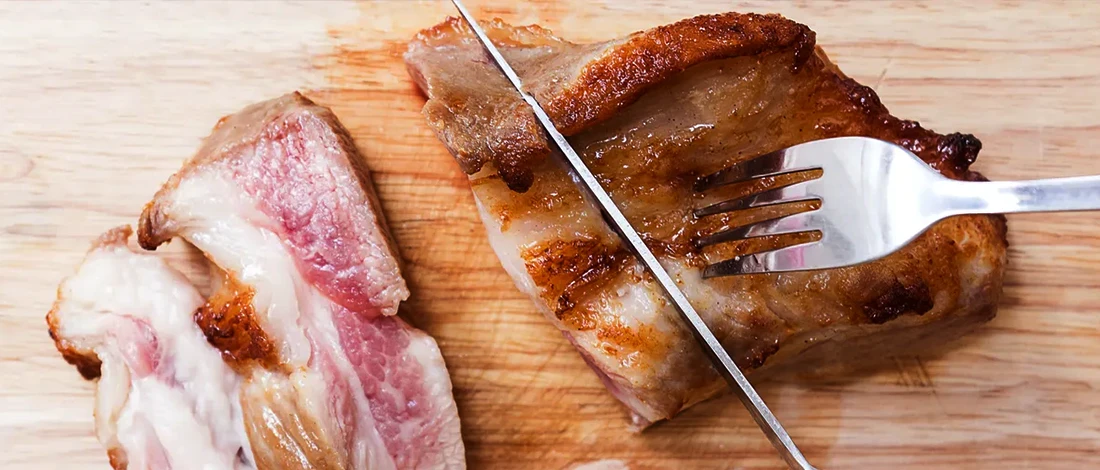Assessing whether pork is good enough for consumption was one of the first things I learned seven years ago when I started my carnivore diet.
I read many research papers and spoke to my local butcher to compile an in-depth guide on safely consuming pork.
When I can’t buy fresh pork cuts, I usually turn to ButcherBox to deliver a wide variety of heritage-bred pork cuts obtained from animals raised crate-free. They sell frozen meat with plenty of ice packs, so it arrives frozen on your doorstep.
I also experimented with leaving different cuts of pork out for various time lengths to find out what would happen.
Here’s what I’ve discovered.
Quick Summary
- You can use your senses to tell if pork has gone bad.
- Don’t eat pork if it has a sour smell or slimy or sticky texture.
- You should check the expiration and sell-by date when buying pork.
How to Tell if Pork Is Bad?
You can tell if pork is bad by smelling it and checking its texture, color, expiration date, and packaging.
1. Smell

The smell is a great indicator that your pork is bad. If it has a sour or ammonia-like odor or a rancid smell, it’s bad, and you should throw it out.
Do a sniff test after you open the package. If it smells fine or there’s no odor at all, the pork is safe to eat.
Note: Raw pork has an ammonia-like smell when it goes bad. Cooked pork has a sour odor that’s different from raw pork. Keep in mind that even cooked pork can still have harmful organisms. Also, be extra careful with flavored cuts, for example, flavored pork sausage. These cuts have a strong smell, and it can be very difficult to detect a bad smell, so sniff carefully.
Pro tip: Packaged pork chops, pork loin, and other cuts can have a faint ammonia smell when you open the package. This happens because of how fresh pork is processed and packaged. You should wash it, and if the smell disappears, you can eat it. But, if pork smells bad after washing, it’s spoiled.
2. Texture
Another way to check if you have spoiled pork is to check the texture, i.e., the meat tissue consistency. If your pork is wet when you take it out of the package, that’s normal.
But, if your pork feels slimy or sticky or dry and mushy, it’s bad. It means bacteria has started spreading, and you can get food poisoning if you eat it.
Pro tip: Press your finger against the pork. If it doesn’t feel firm and your finger doesn’t bounce back, your pork meat is bad.
Note: Sometimes pork feels slimy because your butcher was lazy and didn't scrape the pork chops. Or, there are many juices in the package. The best way to know if pork is bad is to check if there's a bad smell and weird texture at the same time.
“Cook pork, roasts, and chops to 145 ºF as measured with a food thermometer before removing meat from the heat source, with a three-minute rest time before carving or consuming. This will result in a product that is both safe and at its best quality—juicy and tender.”
- United States Department of Agriculture
3. Color

Fresh pork has a glossy and creamy white color. Bad pork has a grayish-to-pink color if left out too long. Cooked pork will be gray with a pinkish interior.
But, if your cooked pork is gray on the inside as well, it’s a sign it may be spoiled. This usually happens if you leave raw meat on the counter for too long.
Also, if your fresh or frozen pork has patches, it’s a sign it’s rotten. Ground pork can have white or green mold, which is another way to tell if pork is bad. You can’t salvage green pork, not even if you cut the green part away.
Spoiled pork can also be a yellowish or brownish color, and if you see any discoloration, it’s a sign your meat has gone bad.
But don’t rely only on color when deciding if you should be cooking pork. Color changes in meat are normal and depend on many factors.
Make sure to check the smell and texture to know if the pork has gone bad.
Related Articles:
4. Expiration Date
As with any other kind of meat, you have to check the expiration date on the package.
It’s always best to use pork before this date to avoid food poisoning.
Note: If your pork is past the expiration date but doesn’t show any of the above signs, it’s still not safe to eat. It can have dangerous levels of bacteria, and even cooking meat at high heat won’t make it safe again.
5. Packaging
Finally, pay attention to raw pork packaging. If it’s puffed up or swollen, your pork has gone bad.
A puffed-up package means bacteria have started to multiply, and it’s producing gases that make the package look puffy.
Note: Sometimes, fresh meat processing makes the package bloat, so you should open it and whiff before deciding if you have spoiled meat.
How to Handle Pork to Prevent Spoilage

Here’s how to handle and cook pork, so it doesn’t go bad:
- Use a thermometer - A meat thermometer helps you know how long pork needs to be cooked. According to the USDA, the internal temperature should be 145 degrees [1].
- Buy fresh cuts - Always buy fresh pork chops so you don’t cook spoiled pork. Check the package for sour or unpleasant odor, slimy texture, and puffiness.
- Store in the fridge or freezer - Store meat in the fridge at 40 degrees or below or in the freezer if you won’t cook pork for longer than three days. Don’t leave pork at room temperature for over two hours, or you’ll have rotten pork. Pork can be frozen between four to 12 months.
- Use separate cutting boards and utensils - Use separate boards and utensils for different kinds of food to prevent contamination. Harmful bacteria easily get transferred from one food and surface to another, which is why you should keep everything separate and clean.
- Transport pork carefully - If your trip home after buying pork isn’t short, prepare proper storage bags that can lock in the cold. You can also put ice packs with the meat to keep the temperature stable.
- Defrost carefully - Defrost pork by leaving it in a covered container in the fridge until it thaws. This usually takes 12 hours or longer, depending on the size of your cut.
Also Read: How to Tell if a Turkey Is Bad
Tips for Storing Pork Safely

Here’s how to store pork so it doesn’t go bad:
- Store in the fridge immediately after you return from a butcher or a grocery store. The fridge temperature should be below 40 degrees [2].
- Store uncooked pork cuts together and keep them separate from cooked foods.
- Store meat in an air-tight container to avoid consuming spoiled pork and prevent bacteria from getting to it.
- Freeze fresh or leftover pork in a sealed freezer bag, so the cold air can’t dry out the meat or cause freezer burn and make it dry.
- Don’t freeze pork again after defrosting.
- Label frozen pork with a note. Write down the cut and the date of freezing.
- If you bought packaged whole pork cuts, keep them in the original packaging for up to five days before cooking.
- Ground pork has a short shelf life, and you can keep it in the fridge for two days before cooking.
- Store cooked pork in the fridge in a container for up to four days.
FAQs
Is It OK to Eat Pork That Smells a Little?
No, it’s not OK to eat pork that smells a little. However, you can rinse the pork or pat it dry with paper towels. If this lowers or removes the smell, it’s safe to eat.
What Happens if You Eat Bad Pork?
If you eat bad pork, you can get food poisoning. Bad pork chops and other kinds of rotten meat cause nausea, vomiting, diarrhea, cramps, fever, and feeling weak.
Can Pork Go Bad Before the Sell-By Date?
Yes, pork can go bad before the sell-by date. However, this is very rare, and it happens if pork isn’t stored, packaged, or processed properly.
References:
- https://www.usda.gov/media/blog/2011/05/25/cooking-meat-check
- https://hgic.clemson.edu/factsheet/safe-handling-of-pork/#








